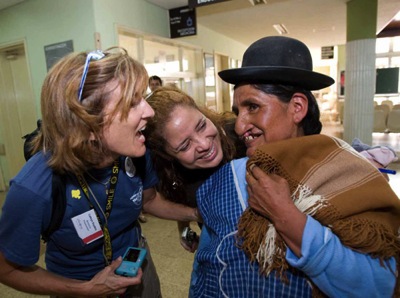by Terry Farmer, Terry Farmer Photography, Springfield, Illinois
March 2008 Operation Smile mission to Bolivia
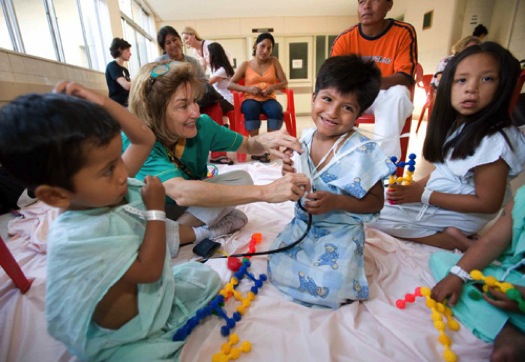
In the sultry heat of a Bolivian fall dozens of prospective patients and their families greeted the 40 medical and non-medical volunteers at Hospital Japones in Santa Cruz. They came hoping for surgery to change their lives through Operation Smile.
Through the chaos that accompanies a mass gathering of people was order born of experience – 11 such Operation Smile missions to Bolivia and dozens in other countries.
Indelible images were everywhere, there was a grade school girl with the ready smile, thick dark braids – and the horrifically deformed nose, infants with cleft pallets sucking on bottles, a preteen boy who had known a lifetime of stares and snickers. Each brought an individual story and all were related by the cruel hoaxes of their birth defects.
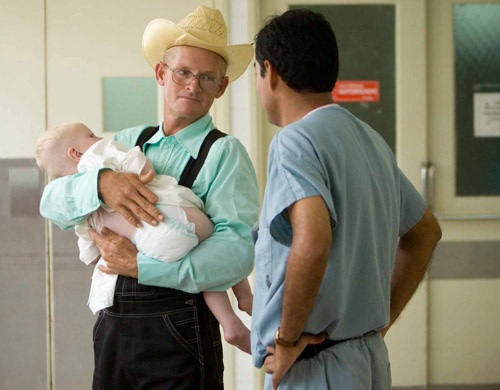 The volunteer team that would change many of their lives forever came from the United States, Canada, Ecuador and Honduras to work with their in-country Bolivian counterparts. These professional team members included plastic surgeons, anesthesiologists, nurses, a dentist, and a speech pathologist.
The volunteer team that would change many of their lives forever came from the United States, Canada, Ecuador and Honduras to work with their in-country Bolivian counterparts. These professional team members included plastic surgeons, anesthesiologists, nurses, a dentist, and a speech pathologist.
Santa Cruz, located east of the Andes Mountains in a lowland area of rolling hills, reflects in many ways the fact that Bolivia is one of the poorest countries in South America. Although this area is rich with oil and gas reserves, the city’s buildings are generally a modest one or two stories high. Small shanties and prosperous homes exist side by side. Buses, luxury cars and horse-drawn carts share the same streets.
Dozens of the 200 or so surgery candidates and their families were lined up, watching as we stepped off the bus on the first day of screening. Some families looked very much like their North American counterparts, wearing jeans and tee shirts. Some mothers in flowered dresses and fathers in pressed bib overalls and straw hats reflected their German Mennonite heritage. And some babies in colorful South American wraps were carried by their mothers.
The detailed screening process for each prospective patient filled the first two days of our stay. In addition to preparing the usual medical charts for each patient, medical personnel took Polaroid and digital file photographs that recorded each patient’s facial deformity prior to surgery.
A psychiatrist talked with the families, explaining what would be involved with each surgery and how lives of the patient and the family would change. A speech therapist described how young nasal voices resulting from a cleft lip or cleft palate would now resonate normally. A surgeon and an anesthesiologist also consulted with each patient.
These were, for some families, days of tedious waiting at the hospital – waiting without enough chairs for everyone – waiting without food, unless they ventured away from the hospital – waiting with no TV to occupy their restless children.
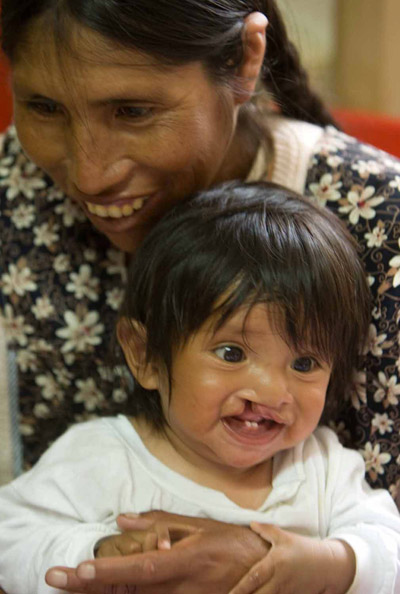 Although Operation Smile is intended for children, there was also an adult who qualified. She won everyone’s heart with her infectious laugh and obvious joy for life. This mother of eight and grandmother of five was just 54. Although her husband was against this reconstructive surgery, she was determined to be able to smile at her grandchildren and not feel ashamed.
Although Operation Smile is intended for children, there was also an adult who qualified. She won everyone’s heart with her infectious laugh and obvious joy for life. This mother of eight and grandmother of five was just 54. Although her husband was against this reconstructive surgery, she was determined to be able to smile at her grandchildren and not feel ashamed.
An Operation Smile surgery was not guaranteed for all the prospective patients. Some were simply too young, and their parents were urged to reapply in another year. Some, like the girl with burns down her side and the boy with facial paralysis, were referred to other medical specialists at the hospital.
Between the days of screening and surgery, the patients and their families waited in a residential shelter, similar in some ways to the Ronald McDonald House concept. During their wait, families went about the routines of daily life, washing clothes by hand and hanging them to dry outside and watching their children play in the yard.
In addition to the medical team, several teen volunteers were part of this mission group, contributing in a multitude of ways. At the hospital, the family shelter and a nearby orphanage, they spent time playing with the children, teaching them about good nutrition and fire safety, and distributing universally favorite toys such as bubbles and crayons.
In preparation for the upcoming surgeries, these teens also made arm braces for the youngest children. The braces were fashioned from cardboard, wood splints and gauze to be wrapped around each arm of the patients so that they would be unable to touch their faces and disturb the surgery site.
The team also explained to parents and children that during surgery the patients’ tongues would be drawn forward between their lips and secured with a suture. This precaution would prevent the patients’ natural tendency to try manipulating the surgical wound with their tongue.
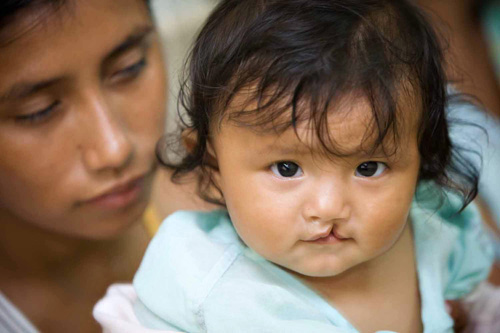
Hospital Japones is a decade-old 200-bed medical facility that was originally financed and initially supported by the Japanese government. This teaching hospital, one of six hospitals and clinics in the city, is associated with three Bolivian universities. Despite its modern, air conditioned facilities, small touches of local life appeared, such as the unkempt dog that sneaked in through an open door and took a four-hour nap under one of the benches.
On the two days of surgery, hospital beds and cribs lined the halls for the young patients, who had been told to arrive at the facility at 6 a.m., regardless of when during the day their surgery was scheduled. Operation Smile provided each child with a small colorful quilt to help them and their parents remember the day.
Dressed in hospital gowns they waited with their parents. Predictably, they cried in fear when it was time to be separated from their family, and their family members often cried with them.
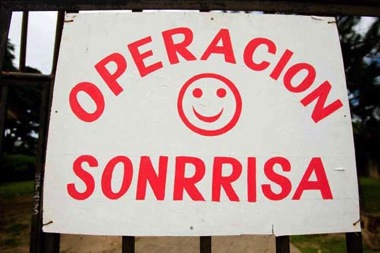 About 120 patients were tenderly cared for during their surgeries by the visiting and local medical teams. During this period five surgeries took place simultaneously in the two surgical suites continuously for 12 hours each day. Because there were not enough surgical lights for all of the simultaneous operations, surgeons often worked by flashlight.
About 120 patients were tenderly cared for during their surgeries by the visiting and local medical teams. During this period five surgeries took place simultaneously in the two surgical suites continuously for 12 hours each day. Because there were not enough surgical lights for all of the simultaneous operations, surgeons often worked by flashlight.
Finally, at regular intervals, the children, their small bodies calm with sedation, were carried out from surgery in the arms of the attending nurses. Many of the parents, once told that the surgeries went well, reacted the way parents around the world react and wept quietly with relief.
They knew that their child would still face additional days of pain and weeks of healing. But their lives had been changed forever and those children would never again face the stares, the pointing and the humiliation that were part of their lives before Operation Smile came to Santa Cruz.
A Personal Note from Terry:
Although I had been a medical photographer intern earlier in my career, each surgery completed in Santa Cruz, Bolivia, through Operation Smile, struck me as an small miracle in a city and for a people whose lives had lacked many positive, life-changing experiences.
The thought that overwhelmed me every day was, “We’re so fortunate in the United States, so very blessed.” We may not be able to afford superior medical care, but we seldom face the extra burden of how to reach a doctor. When I saw families traveling in horse-drawn carts on dirt streets through the city, I wondered how “our” families reached us…and how long it took.
When we travel as families, most parents pack toys and snacks to keep their children occupied. There were none of those at Hospital Japones. And yet, the children were as affectionate as they are in my neighborhood, which made their enthusiastic hugs and smiles all the more heartwarming.
Whereas I’ve taken part in a different type of mission trip to Appalachia, I saw a depth of poverty and lack of community services that exceeded any of my previous experiences. Wives stand outside in front of their homes to cut up chickens for dinner. Trash clogs trenches built originally for storm water runoff.
And I witnessed professional success using the very basics of our craft. A photographer in front of the city cathedral captured images on film with an ancient camera. Then, on the spot, he developed prints using light-tight sleeves and chemicals in little sardine cans. It took just 10 minutes and cost a meager $1.50 per print.
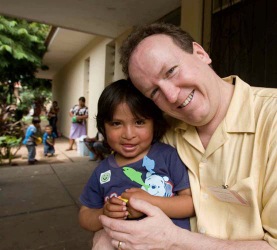 The warmth of the families we served and the others we met, the privilege we had to serve and work with them, the enthusiastic volunteers who treated every patient as if they were treating a family member…this amazing experience is indelibly etched in my mind.
The warmth of the families we served and the others we met, the privilege we had to serve and work with them, the enthusiastic volunteers who treated every patient as if they were treating a family member…this amazing experience is indelibly etched in my mind.

